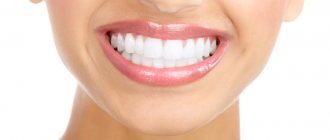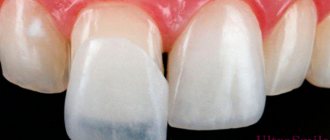October 31, 2017
Chips are a problem that occurs much more often than it might seem at first glance. A piece breaks off, as a rule, on the front teeth, because they are not designed for heavy loads, but it is with them that we most often bite off hard bones, it is on them that we fall unsuccessfully or damage them due to bad habits (for example, gnawing seeds or biting the tip of a pencil ).
Many patients are interested in how to restore chipped front teeth. We present to you the three main methods that a dentist can offer. The editors of the UltraSmile.ru portal decided to figure out which of them is the best in terms of price-quality ratio.
Artistic extension
Artistic restoration is a method in which chips are restored using various restoration materials (we are talking about composites - they are also used for classic tooth filling). They allow you to replicate the shape, color and transparency of a natural tooth.
Such restoration is carried out directly in the patient’s mouth - using polymers or composites, the doctor restores the integrity of the tooth, literally building it up. The advantage of the technology is speed (they came to the doctor and left with new teeth), as well as the price. The cost of restoration is from 2-3 thousand per element.
Artistic restoration
Among the disadvantages is not too long service life. The extended tooth will last about 3-5 years. At the same time, it will have to be protected from stress and regularly polished so that the composite remains smooth - otherwise, if there are micropores, bacteria, plaque and coloring pigments of products will accumulate in them. The color of the restoration will change.
On a note!
If the chip is strong, that is, almost to the root, you can install a pin or stump inlay inside the canals, and then build up the crown using composites.
This option will extend the service life for several more years. Video review from a patient about artistic restoration of anterior teeth.
Restoration of chewing teeth
Restoration of chewing teeth is performed using direct and indirect methods.
In the first case, the latest generation nanocomposite material is used, which is applied in 1 visit (after plaque removal). If there is a large loss of tooth tissue, it may be necessary to install a pin in a previously prepared root canal.
In the second, significant loss of the coronal part is restored using inlays. They are made from durable pressed ceramic. Installation of a microprosthesis of this type protects against the re-development of caries and allows you to preserve living tissue of the molar (if depulpation is not performed).
Veneers and Lumineers
Veneers are thin veneers made from ceramic or zirconium. They are fixed on the front part and completely hide almost all imperfections - gaps in the row, discoloration, pigmentation, as well as small chips and cracks. Naturally, this option is more expensive. By the way, if there is a large chip, the tooth will still have to be restored first, namely, extended. But the technology can be carried out more mediocrely, using less expensive options, since it will be covered with overlays.
Lumineers
The cost of installing veneers is from 20 thousand per tooth. Such onlays are installed in 2 visits - during the first visit, the enamel is prepared (part of it is ground down for a better fit of the veneers), during the second, the onlays are directly fixed.
“I’ve been wanting to get veneers for a long time, because there were several chips! There were extended restorations everywhere. The only thing that put me off was the price - it is, of course, very high, because you have to put it on several teeth at once to make it look beautiful. Just recently I met a dentist who offered me a very good discount))) I am simply incredibly happy with the result!!! I'm not ashamed to smile, everything looks great, so I recommend it to anyone who has doubts. The main thing is to find your doctor!!!”
from correspondence on forums
Direction: Installation of veneers
Ximera
Prevention
To minimize the likelihood of chips and other mechanical damage, dentists recommend following the following rules:
- monitor oral hygiene, brush your teeth twice a day, use mouthwash and dental floss;
- limit consumption of sweets;
- eat right, eat foods rich in calcium, fluorine, phosphorus, vitamin C;
- stop smoking;
- Regularly (at least twice a year) undergo a preventive examination with a dentist.
You can find out the cost of restoring a chipped tooth and make an appointment with a dentist right now by filling out a simple online form on the website or calling the specified phone numbers.
Crowns for teeth
Another option to solve the problem is crowns. They completely cover the damaged tooth, or rather, its top. They are used in cases where the chip is so severe that neither extensions nor veneers are suitable.
For front teeth, it is better to choose crowns without metal in the base - such material can show through in the light and the restored tooth will look dark. Therefore, preference should be given to ceramics or zirconium. The cost of such prostheses is from 15 thousand rubles.
Crowns for front teeth
Restoration of anterior and chewing teeth
When restoring the incisal edge of the anterior units, it is very important to correctly model the transparency zone so that the tooth looks as natural and aesthetic as possible.
If a patient has a chipped wall of a side tooth, then the main emphasis when restoring the chip is on restoring the exact shape and ensuring strength. Therefore, materials are used that have high tensile, compressive, and fracture strength characteristics. The specialist selects the appropriate treatment tactics based on the degree of destruction.
Which method is better?
To summarize: artistic extensions are cheap, but not very durable. Veneers need to be installed on several teeth at once in order to fully transform your smile, which means it will be quite expensive. Crowns allow you to restore even one tooth, and you can choose a very aesthetic option. Which of the following should I choose? It’s difficult to say - only a doctor can give an exact answer, knowing and seeing the initial situation (and also taking into account your financial capabilities). Therefore, we still recommend trusting your choice to your orthodontist, who will be able to offer a solution that is the most optimal in appearance, quality and affordable.
Options for restoring chipped front teeth
Notice
: Undefined variable: post_id in
/home/c/ch75405/public_html/wp-content/themes/UltraSmile/single-item.php
on line
45 Notice
: Undefined variable: full in
/home/c/ch75405/public_html/wp-content /themes/UltraSmile/single-item.php
on line
46
Rate this article:
veneers, lumineers, chips
Dental restoration methods in Moscow
The PROFI-Dent dental restoration clinic provides high-quality dental care to everyone who values their health and is committed to an impeccable result.
In our dentistry, dental restoration is carried out using two methods:
- Direct – recreating the anatomical shape of the tooth by layer-by-layer application of composite materials.
- Indirect - tooth modeling with artificial segments (veneering).
We treat each patient with the utmost attention, doing everything possible to solve the dental problem in the shortest possible time, while the cost of dental restoration in our clinic is one of the lowest in Moscow.
All procedures and manipulations are carried out using modern equipment and advanced materials. The modern dental restoration technologies used by our specialists make it possible to achieve truly exceptional results, preserving maximum healthy dental tissue.
Restoring a chipped tooth
Most patients after mechanical damage have a logical question: how to fix a chipped tooth? The treatment method for chipped teeth depends entirely on the type and degree of damage. Today, technology makes it possible to restore a chipped tooth of almost any severity, but this requires resorting to complex and expensive therapeutic and orthopedic procedures.
| Problem | Description of methods |
| Light chips and cracks (treatment of chipped tooth enamel) | For minor enamel cracks, mineralization and fluoridation are used to restore its protective functions and prevent the cracks from deepening. For minor damage, filling is usually not required. If there is no risk to functionality and aesthetics, then the doctor suggests grinding down the chipped tooth. |
| Moderate chips | If the damage has affected the dentin, then filling is no longer possible. The same can be said about severe chips and cracks in the enamel. Often, chipped teeth are built up with composite materials and restored with inlays. |
| Heavy enamel chips. | If the pulp has been affected, then before starting to restore the chipped tooth, it is necessary to carry out endodontic treatment with removal of the pulp and filling of the canals. In case of chips under the gum and deep clefts of the tooth, its complete or partial removal with subsequent installation of a crown or implant may be indicated. In situations where a large part of the tooth is missing, installing veneers and inlays is almost impossible. |
Basic methods of teeth extension and restoration
- Composite building - the main characteristics and advantages of the method of restoration with such material
For this type of extension, composite filling materials are used. These multi-component compositions allow you to reliably and quickly remove the defect, restoring a beautiful row of teeth. The material is exposed to ultraviolet rays, causing the base to harden. The average lifespan of a tooth augmented with this material is up to 10 years. Over time, the filling loses its strength and aesthetic characteristics, and therefore it is recommended to repeat the extension.
Advantages of composite fillings when building:
- a fairly reliable filling for a tooth, but slightly inferior to a photopolymer;
- service life after this method of extension is up to five years;
- affordable treatment - cheaper than photopolymer.
- Photopolymer extension – features and advantages of the restoration method
- impeccable aesthetics;
- the reliability of the photopolymer is higher than that of composites;
- a variety of complexity groups, which allows you to close almost any defects;
- service life after extension – up to ten years;
- The photopolymer hardens quickly. Restoring the structure in this way is very comfortable for the doctor.
Teeth augmentation with photopolymer (dental light polymer) is a method of restoring the integrity of a tooth using a light-curing material. A photopolymer (monomer or low molecular weight monomer) hardens when exposed to light.
Advantages of photopolymer fillings for tooth extension:
What is the difference between the method of tooth augmentation with composites and photopolymer restoration? Composite means a combination of substances, that is, several chemical components are mixed to form a filling, and a “chemical multi-component filling” is obtained. Composites are used to restore the back of the tooth, and photopolymers are used for the front zone of the smile, which is why the latter materials are an order of magnitude more expensive than composites.
A veneer is a thin plate that sits on a tooth using a special glue. The main goal of a dental procedure is to give teeth a flawless appearance in terms of color, shape and clarity. The method of building up teeth with such onlays is more of an aesthetic restoration. Veneers, as a rule, are placed on the smile zone (front 8 - 10 units) of the upper jaw, and the lower teeth (if they are healthy) are whitened to the shade of the plates themselves.
Advantages of veneers for tooth extension and restoration:
- impeccable appearance;
- speed of manipulation;
- the ability to use extensions to correct a slight curvature of the tooth;
- plates can cover chips, microcracks, yellowish or brownish stains on teeth, thinning enamel;
- veneers correct the presence of gaps between teeth;
- the linings retain their shape, color, and transparency throughout their entire service life.
Depending on the installation method, there are the following types of veneers for teeth extension:
- ceramic – ready-made plates that are pre-fabricated in a dental laboratory. They are considered more reliable than composite ones, but at the same time they are several times more expensive;
- composite - the same composite fillings that are built up by an esthetician dentist directly in the patient’s oral cavity.
The main nuance of installing ceramic plates is the need to grind down healthy tooth enamel before the extension. And this process is irreversible, i.e., if you want to refuse veneers in the future, they will be removed, but the tooth will be without the top layer.
Installing a ceramic veneer does not mean that it will last the patient’s entire life after the extension. Firstly, dental veneers are quite fragile and can break or fall off, especially when eating hard foods. Secondly, over time, even the highest quality ceramic veneers need to be replaced, because... their service life is up to twelve years.
The method of building up with crowns can be called full-fledged prosthetics. It helps when the patient has lost most of a tooth, or has no tooth at all. Ceramic crowns are suitable for both the restoration of front and back teeth. And this is the optimal solution when the amount of tooth destruction is up to seventy percent, and it urgently needs to be increased. To build up a damaged tooth, the dentist grinds it down and makes an impression, according to which an individual ceramic crown is made in a dental laboratory. After this, the crown is tried on, and if the result is positive, it is “set” on dental cement.
Types of dental crowns:
- from metal ceramics;
- ceramic crowns.
Advantages of ceramic crowns for teeth:
- versatility;
- good aesthetics;
- affordable price.
When installing even the highest quality ceramic crowns, no one is safe from their accidental loss. This is especially true for building up front teeth. It’s one thing to build it up, and another thing to take care of your smile so as not to spoil all the beauty!
Causes
- Dental trauma. Falls and impacts are the main reason why chips and cracks occur in perfectly healthy teeth;
- Negligence towards one’s health and bad habits (opening beer bottles with teeth, cracking hard nuts with them, gnawing hard objects, etc.);
- Demineralization of tooth enamel. A process that leads to weakening of enamel and increased risk of injury;
- Carious lesions. They damage the structure of enamel and dentin and thereby make the tooth more vulnerable to mechanical stress. Depulpation completely “kills” the tooth: the tissues, not receiving nutrition from the pulp, become very fragile;
- Bite abnormalities. Cause improper load distribution, which increases pressure on individual teeth or areas of the dentition;
- Incorrect filling. Due to an incorrectly installed filling, the chewing tooth often chips;
- Poor nutrition and poor hygiene. An indirect cause that affects dental health in general;
- Weakened immunity, bad genetics.
How much does tooth restoration cost in Moscow?
By contacting PROFI Dent dentistry, you will be convinced that inexpensive dental restoration in Moscow is by no means a myth, but a real opportunity to make your smile beautiful.
The cost is influenced by many factors - the complexity of the case, the amount of work, the technology used, the price of the material, the need for additional procedures, etc.
The doctor will announce the final price during the consultation, after the examination, and you can familiarize yourself with the price list now.
| Price list for prosthetics at the PROFI-Dent clinic | |
| Restoration of wedge-shaped defect, enamel erosion | from 3,000 rubles |
| Restoration of the frontal group | from 5,000 rubles |
| Filling made of light-curing material | from 2,200 rubles |
| Artistic restoration made from light-curing material | from 5,000 rubles |
| Ceramic-composite veneer | from 8,000 rubles |
| Installation of dental jewelry | 1,000 rubles |
Differences between a chipped tooth and other types of damage
In dentistry, a chipped tooth is any type of mechanical damage leading to disruption of the anatomy and structure of tissues. Experts have different interpretations of this concept. For example, you can find diagnoses such as “chipped the tooth wall below the gum level” or “chipped the tooth wall under the gum.” However, in the classical sense, this is damage to the coronal part (in other words, a chipped tooth crown). Trauma does not imply its loss or change in position relative to the jaw and damage to the ligamentous apparatus. You should also distinguish between chips and root fractures, since in the second case the damage affects the root part. In this case, combined injuries also occur, when, for example, a chip of the crown part and tooth dislocation are diagnosed at the same time.











